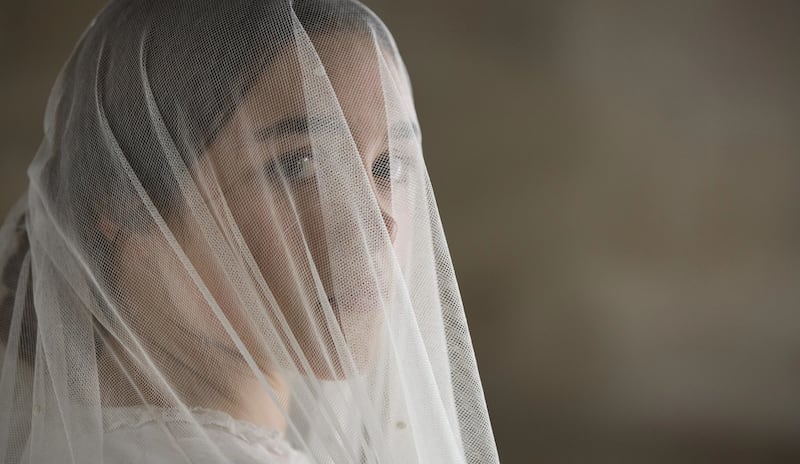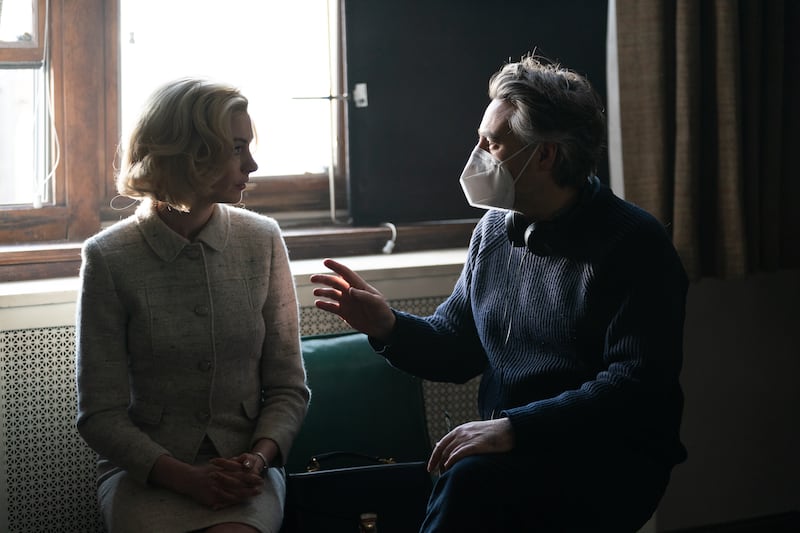Ottessa Moshfegh may now be a little too successful to count as a cult heroine. Novels such as Eileen, Lapvona and My Year of Rest and Relaxation have done good (evil) work in defining particular modern discontents. Uneasiness about the body. Suspicion of intimacy. All wrapped up in jet-black humour. The American author, born in 1981, offers a counterblast to those ageists still painting millennial culture as pallid and weedy. Her books have guts. Sometimes those guts get spilled.
I jokingly tell William Oldroyd, the English director of an incoming cinematic adaptation of Eileen, that I would feel slightly afraid of meeting her.
“Oh, you shouldn’t be. She’s wonderful,” he says, laughing. “She creates such vivid characters. That’s what drew me to want to make Eileen. If you find such compelling characters you’ll get good actors. Good actors want to play great and complex characters. And it’s so much better to make a movie with great actors.”
Moshfegh’s first novel, a Booker nominee published in 2015, is a grim period piece in the style of Patricia Highsmith. The eponymous protagonist lives a grey life in an icy corner of Boston during the mid-1960s. Her father is a brute. Her job at a juvenile detention centre is unspeakably grim. Sparkle and hope enter her life when Rebecca Saint John, a glamorous psychiatrist, arrives at the institution. Eileen’s jaw drops as she moves into dangerous intimacy with the newcomer. Oldroyd is right about getting good actors. Thomasin McKenzie is clenched as Eileen. Anne Hathaway gleams as Rebecca.
READ MORE
“How lucky we were to get Thomasin to play to play this part,” says Oldroyd. “She was just perfect. And the character of Rebecca Saint John? Another extraordinary complex character. It was obvious that it appealed to Anne Hathaway, who was very interested in playing the role.”
Oldroyd and I last met when he brought Lady Macbeth, his 2016 debut, to Dublin International Film Festival. The adaptation of Nikolai Leskov’s Lady Macbeth of the Mtsensk District was a sensation. Like Eileen, it focused on a strong woman who would tolerate no dismissal. The film made a star of Florence Pugh and brought attention to Oldroyd. A theatre director who studied theology after school, he looks to have taken his time in following up that project.
[ Lady Macbeth review: A five-star stone-cold instant classicOpens in new window ]
“I have a file on my computer,” he says. “There are about 20 or 30 projects in there that I haven’t made. One of the key things was nobody expected Lady Macbeth to get the attention it got. There was a lot of noise associated with that. There were a lot of people telling you what you should and shouldn’t be doing. You can get a bit confused. So I had to wait for the noise to die down, so I could think straight.”
He read Eileen doing lockdown for pleasure.
“I just thought, What a great story. What a great character. And so I asked whether we could meet, Ottessa and I, to talk about adapting it for a film. It took the time it took. I didn’t want to rush into something I didn’t love. It had taken me 36 years to make Lady Macbeth. Right? So I thought, What’s five more?”
Yes, but he wasn’t doing that alone in the 36 years of life that led up to his first film.
“Yes, ha ha. I had to go to school and so on.”

That was not Pugh’s first performance. Carol Morley cast her as a schoolgirl in the dreamy The Falling, from 2014. But Lady Macbeth was a star-making turn. There seemed no alternative to her ascension after that triumph. She was Oscar-nominated in Little Women. She secured Marvel Cinematic Universe action in Black Widow. I wonder if Oldroyd and his colleagues saw all that coming. Does he bear some responsibility for her rise? He modestly points towards a legendary casting director.
[ The Falling review: Kitchen-sink grit and otherworldly mysteryOpens in new window ]
“Shaheen Baig is to be credited, because she cast Carol’s film,” he says. “Florence was cast out of school for The Falling. I saw The Falling, and it was Shaheen who said Florence would be perfect for Catherine. It’s not just Florence. It’s Cillian Murphy. And it’s Barry Keoghan. It’s Jack O’Connell. There is a good bunch of people who Shaheen discovered. But I think Florence is amazing. Even without Lady Macbeth she would have gone on to be very, very successful. A rare actor of her generation.”
Anyway, back to the follow-up. Eileen plays with an interesting period in American cultural life. It is 1964. “The Sixties” are happening in New York and Los Angeles. They may be happening a little in nearby Boston. But the film is set in a corner of New England that has yet to drag itself out of the previous decade. It is all dust and gloom and depression. We hear great tunes, but they echo the lush sounds of a fading era. There are no Beatles here. The Rolling Stones are elsewhere.
“Yes, exactly. We even talked about the fact that this is not Boston,” he says. “This is a small coastal town outside of Boston. So, really, we’re talking about the late 1950s in the 1960s. If you go to the bar you’re not going to get the latest records on the jukebox. You’re going to get stuff from the late 1950s. Whatever is happening in Boston with women’s liberation, it has not hit here yet. We thought at one point, Is everyone in this town a cop? It’s a prison community. It is symbolic that Eileen works in a prison, and Rebecca comes in and releases her.”
Both the film and the book concern society’s discomfort with female sexual desire. Eileen is forced into treating her own longing as a guilty secret on which cold water – literally snow, here – must periodically be dumped. Rebecca may be a something of a phoney, but that is not to suggest she doesn’t point towards escape.
“Looking at Lady Macbeth and Eileen, the problems in those films, even though they are set in 1860 and 1960, haven’t gone away,” he says. “I went to an exhibition yesterday in Tate Britain about Greenham Common,” he says, referring to the women’s peace camp set up outside the English RAF base after the decision to house almost 100 nuclear missiles there. “It’s about women’s oppression. It is a fantastic exhibition. But we still have the same problems. In this country and in the US.”

He addresses the American backtracking on abortion rights.
“I find it fascinating that there was a step backwards in terms of the supreme court’s decision on Roe vs Wade. Here we are in 2023. And that’s happening. No wonder people are looking at movies like Eileen, which is about the suppression of women, and find that it still speaks to them. The things people find startling about those films is women act out of their time. That’s not how they were supposed to behave.”
On a more trivial note, Eileen now enters one of the more stubborn yearly debates. It joins Die Hard, Batman Begins, Tangerine, Trading Places and Todd Haynes’s Carol – a film that rhymes solidly with Eileen – in the list of unconventional “Christmas films”. Fools try to deny them that honour. But Eileen has Christmas trees, seasonal pageants and plenty of snow. It may be miserable. But then so is Christmas for many. Oldroyd chuckles at the question. The good people at Neon, who also distributed Triangle of Sadness and the Oscar-winning Parasite, were on board.
“I love it. For me it’s the perfect Christmas love story,” he says. “Neon were so happy to work on this film. They really understand how to promote the film and distribute it. They said, ‘If Neon were going to make a Christmas movie, this would be it.’ We were, like, ‘Great, let’s do this.’ They wanted to release it on December 1st. If you want to see something different this is the Christmas movie for you. Right?”
Bar one structural shift (which we won’t spoil), the film is faithful to the book. This is not altogether surprising. Moshfegh’s prose plays out in cinematic terms. One could sense the winter light floating round the crackling street lights. Faithfulness is not a virtue in itself, but it is nonetheless worth noting how much of that flavour translates so comfortably to the screen. It is a post-noir novel. This is a post-post-noir movie.
“I read it almost in one sitting,” says Oldroyd. “And that was something that struck me. She had created such beautiful images on the page. I thought they would translate to the screen very easily. They were things I hadn’t really seen before. I dug up some photography from the time and felt, This is great.”
It really does sound as if Oldroyd and Moshfegh have formed a fecund creative partnership. As we speak, they are poking through historical records for their next collaboration. “It would be based on the last woman in England to be tried as a witch – in 1943,” he says. “The last time the Witchcraft Act of 1735 was used. It convicted a Scottish medium called Helen Duncan.”
That sounds almost too promising for words.
Eileen is in cinemas from Friday, December 1st



















